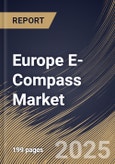The Germany market dominated the Europe E-Compass Market by country in 2024, and is expected to continue to be a dominant market till 2032; thereby, achieving a market value of $162.7 million by 2032. The UK market is exhibiting a CAGR of 8.7% during 2025-2032. Additionally, the France market is expected to experience a CAGR of 10.6% during 2025-2032. The Germany and UK led the Europe E-Compass Market by Country with a market share of 24% and 17% in 2024. The Italy market is expected to witness a CAGR of 10.4% during throughout the forecast period.
The Europe e-compass market has grown from early academic and defense-focused magnetic sensor experiments to a fully developed system of integrated orientation modules that are used in consumer electronics, cars, industry, aerospace, and robotics. At first, universities and aerospace companies in France, Germany, and the U.K. were the ones who wanted magnetometers. Over time, they were combined with accelerometers and gyroscopes to make strong tilt-compensated heading possible. Consumer adoption, especially in smartphones, wearables, and automotive applications, sped up the integration of 9-axis orientation modules and software fusion libraries. This made it possible to get stable heading output even in environments with a lot of magnetic noise. The demand for e-compasses in automotive ADAS, autonomous mobility programs, and high-end defense and robotics applications all at the same time made calibration robustness, real-world performance under interference, and long-term reliability even more important. This changed e-compasses from niche components into essential orientation tools.
Current trends in Europe point to advanced sensor fusion, hardening for cars, and tiny ultra-low-power solutions. Magnetics, inertial sensors, GNSS, and visual cues are all examples of multimodal fusion. This helps reduce magnetic distortion. Anomaly detection and adaptive calibration make sure that the heading is accurate in complex environments. Automotive applications require modules that have been tested for electromagnetic compatibility (EMC), temperature cycling, and vibration tolerance, and that have a predictable lifetime of performance. These modules also need to support redundant orientation in critical systems. In the meantime, the consumer and industrial wearable markets put a lot of emphasis on power efficiency, dynamic wake/sleep operation, and cloud-assisted heading correction. Top European suppliers stand out by offering integrated hardware-algorithm platforms, working with OEMs to design new products, thorough testing, and support after deployment. This makes orientation modules not only accurate but also serviceable, trusted parts of Europe's connected, automated, and industrial ecosystems.
Axis Orientation Outlook
Based on Axis Orientation, the market is segmented into 3-Axis, 6- & 9-Axis Sensor Fusion and 1-2-Axis. The 3-Axis market segment dominated the Germany E-Compass Market by Axis Orientation is expected to grow at a CAGR of 8.1 % during the forecast period thereby continuing its dominance until 2032. Also, The 1-2-Axis market is anticipated to grow as a CAGR of 9.6 % during the forecast period during 2025-2032.Application Outlook
Based on Application, the market is segmented into Consumer Electronics, Automotive (Navigation, ADAS), Aerospace & Defense, Industrial & Robotics, Marine & Sub-sea, Healthcare & Wearables, and Others. Among various UK E-Compass Market by Application; The Consumer Electronics market achieved a market size of USD $21.2 Million in 2024 and is expected to grow at a CAGR of 7.3 % during the forecast period. The Marine & Sub-sea market is predicted to experience a CAGR of 10.8% throughout the forecast period from (2025 - 2032).Country Outlook
Germany is a key place for e-compass adoption because it has a strong electronics supply chain, a strong automotive industry, and a well-developed industrial ecosystem. The need for high-precision orientation sensors is growing in navigation systems, self-driving cars, robotics, and industrial instrumentation. This is because of Industry 4.0 initiatives, smart factory automation, and the growing use of AGVs and robotics. Some important trends are miniaturized MEMS-based multi-axis sensor fusion, better calibration algorithms, and modules that work best in low noise and stable temperatures. The competitive landscape includes global sensor leaders and German integrators. They set themselves apart by offering local calibration, customization, and easy integration with automation platforms. To meet Germany's strict industrial standards, strategic moves include setting up local calibration labs, working with OEMs, and improving support on the ground.List of Key Companies Profiled
- STMicroelectronics N.V.
- Asahi Kasei Corporation
- Robert Bosch GmbH
- Honeywell International, Inc.
- NXP Semiconductors N.V.
- TDK Corporation
- Infineon Technologies AG
- MEMSIC Semiconductor Co., Ltd. (IDG Capital Investment Consultant Beijing Co Ltd.)
- Allegro Microsystems, Inc. (Sanken Electric Co., Ltd.)
- Garmin Ltd.
Market Report Segmentation
By Axis Orientation
- 3-Axis
- 6- & 9-Axis Sensor Fusion
- 1-2-Axis
By Technology
- Hall-Effect
- AMR / GMR / TMR
- Fluxgate
- Magneto-Inductive
- Quantum (NV-center, Optically-pumped)
By Form Factor
- Integrated Sensor-Combo (Accel + Mag)
- SoC-embedded e-Compass
- Discrete Compass Modules
- Dev-Boards & Custom ASICs
By Application
- Consumer Electronics
- Automotive (Navigation, ADAS)
- Aerospace & Defense
- Industrial & Robotics
- Marine & Sub-sea
- Healthcare & Wearables
- Others
By Country
- Germany
- UK
- France
- Russia
- Spain
- Italy
- Rest of Europe
Table of Contents
Companies Mentioned
- STMicroelectronics N.V.
- Asahi Kasei Corporation
- Robert Bosch GmbH
- Honeywell International, Inc.
- NXP Semiconductors N.V.
- TDK Corporation
- Infineon Technologies AG
- MEMSIC Semiconductor Co., Ltd. (IDG Capital Investment Consultant Beijing Co Ltd.)
- Allegro Microsystems, Inc. (Sanken Electric Co., Ltd.)
- Garmin Ltd.








